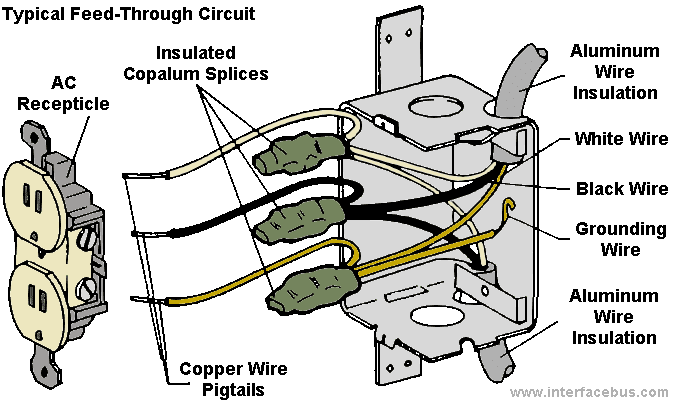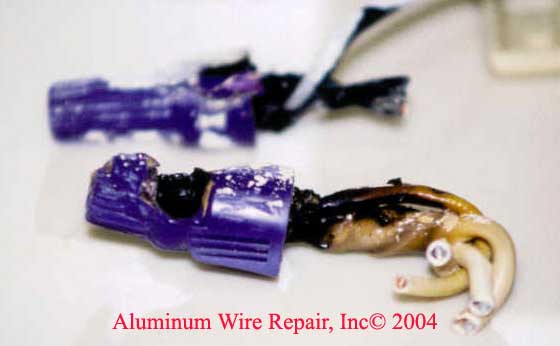4.9 1890+ Google Reviews

Aluminum wiring often refers to the single-strand solid wiring used in homes from the late 1960s through the 1970s. Unbeknownst to electricians installing it at the time, it would later cause many fires and deaths. In fact, The U.S. Consumer Product Safety Commission (CPSC) estimates that it is 55 times more likely to cause house fires than copper wiring.
Aluminum wiring itself is not dangerous. However, every outlet, light fixture, junction box, and connection point is potentially dangerous. The two main factors that make it more dangerous are expansion and galvanic corrosion.
Aluminum expands much more than copper wiring. As electricity flows through the wire, it heats up, expands, and then cools down and contracts when the circuit is off. This repeated expansion and contraction creates loose connections at terminal screws, pigtails, and other splices. Loose electrical connections cause arcing, which can lead to electrical fires.
The next factor is galvanic corrosion. Galvanic corrosion occurs as a result of two dissimilar metals touching. At the time, most electrical devices, such as circuit breakers and outlets, were made with copper or brass contact points. The use of aluminum wiring created electrical connections prone to galvanic corrosion. Copper and brass are similar and not prone to galvanic corrosion, but aluminum is much different than copper and brass. This corrosion leads to the deterioration of the electrical wire leading to poor connections, high electrical resistance, increased heat, and potential fires.
Copper prices continually rose in the late 1960s, and aluminum wiring became a cost-effective alternative. Interestingly, in 1974 copper prices were rising so rapidly that people began to hoard pennies. They thought that, eventually, the copper in the penny would be worth more than the cost of the penny itself.
In fact, at the peak of copper prices, copper recovered from a melted penny would have netted 1.04 cents.
This resulted in a nationwide penny shortage. Banks paid $1.05 for 100 Pennies, stores required exact change, and the government imposed strict penalties for melting down the coins.
Eventually, the price of copper dropped, and the great penny shortage ended.
Likewise, electricians and building code officials began to realize the inferior and dangerous qualities of aluminum wiring.
The easiest way to know if you have aluminum wiring is to look inside the electrical panel. With the cover off, you’ll be able to see all the wiring and discover if any of it is aluminum. Most of the wiring has wire insulation, so look at the ends of the wire for shiny silver-like wire.
Additionally, you can look inside outlets and junction boxes, but this is more difficult. If you’re unsure, you can hire a licensed electrician or home inspector to evaluate the home.
Not all aluminum wiring is bad. Modern aluminum wiring is a different blend of alloys that addresses the shortcomings of the aluminum alloy from the early 70s. The National Electrical Code (NEC) allows aluminum wiring in a residential home as long as its AA-8000 series electrical grade aluminum alloy conductor material.
In addition, the devices in the home must be listed for aluminum wiring connections.
In regards to an older home, only solid wires are considered dangerous. There were no problems associated with multi-strand wiring.
Homes built in the late 1960s and early 1970s may have aluminum wiring. Keep in mind that a new home with aluminum wiring is not a concern. It's modern replacement is code approved and safer than its predecessor.
The CPSC tested many different kinds of aluminum wiring repairs. They concluded that full replacement and COPALUM connectors were the only ideal repairs and that alumiconn connectors were sufficient if the prior were not viable options. In addition, they outlined pig tailing and CO/ALR devices as insufficient repairs.
Complete replacement of aluminum wiring is the ideal repair. However, a qualified electrician would need to remove all the wires in the house and pull new ones through. This involves making numerous holes in the walls and is very expensive. The average cost to rewire a home is $2-$4 per square foot.
COPALUM connectors are also considered a permanent repair for aluminum wiring. The repair involves splicing the original solid aluminum wire into a piece of copper wire with a specially designed metal sleeve. Then the small piece of copper wire is connected to the device instead of the aluminum. The connection is made with a special tool that applies over 10,000 pounds of force. Then heat shrink is used over the splice to create an airtight connection.
The problem is this splice is required at all of the aluminum wire connections in the home, including all the outlets, light fixtures, junction boxes, etc. Plus, the manufacturer only sells the tools and connectors to electricians specially trained to use them. The result is a time and labor-intensive job that is unavailable in many areas of the country.
COPALUM connectors are also considered a permanent repair for aluminum wiring. The repair involves splicing the original solid aluminum wire into a piece of copper wire with a specially designed metal sleeve. Then the small piece of copper wire is connected to the device instead of the aluminum. The connection is made with a special tool that applies over 10,000 pounds of force. Then heat shrink is used over the splice to create an airtight connection.
The problem is this splice is required at all of the aluminum wire connections in the home, including all the outlets, light fixtures, junction boxes, etc. Plus, the manufacturer only sells the tools and connectors to electricians specially trained to use them. The result is a time and labor-intensive job that is unavailable in many areas of the country.

That brings us to the AlumiConn Connectors. AlumiConn connectors are similar to COPALUM in that connectors are used to splice small pieces of copper wire to the original aluminum wiring. However, the difference is that AlumiConn connects use regular screws to make the connection, so no special tools are needed.
Since no special tools or training are needed, this repair method is more widely available.

An electrical pigtail is splicing two or more wires with a twist-on connector (wire nut). Although many electricians resort to pig tailing to repair aluminum wiring, the CPSC clearly says this is not a good repair. In fact, the CPSC says pig tailing aluminum wires makes them more prone to fires than if left alone.

This is the second repair that the CPSC warns explicitly against. It involves replacing all the switches and outlets with listed CO/ALR devices. These devices are supposedly compatible with aluminum wiring and reduce fire risk. However, the CPSC stated that these devices failed just as often in laboratory tests as other devices.
Plus, these devices would not address connections made in junction boxes and hardwired appliances.
There is no reason to turn down the home of your dreams simply because it has aluminum wiring. Home inspections will reveal any number of problems with a home, and this is just one of them. You should talk with your Realtor to determine if you can negotiate repairs or credits from the home seller. If not, you’ll have to determine if your finances support addressing any issues uncovered by the home inspection.
According to the International Association of Certified Home Inspectors (InterNACHI), home inspectors are not required to identify the presence of aluminum wiring. However, many inspectors are familiar with and do report on it.
Every insurance company is different, provides different coverage, and has different exclusions. There are insurance companies that will deny coverage for aluminum wiring. However, others may require an inspection of the wiring before issuing a policy. In any case, you’ll need to make your insurance company aware it and determine what their individual policy is.
Aluminum wiring is something that home buyers, sellers, and real estate agents should be familiar with. It’s a type of wiring used in the late 60s and early 70s that is much more prone to excessive heat and fires than copper. If you are buying or own an older home with it, you should contact a professional electrician for a full evaluation.